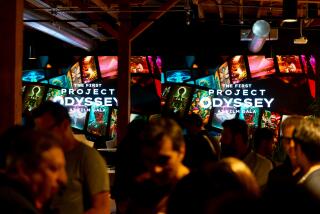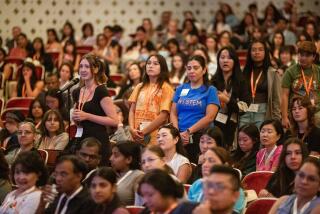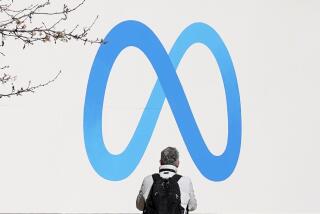Science Fair’s White Mice Give Way to Computer-Age Sophistication
- Share via
David Liu, one of more than 580 competitors in the annual California State Science Fair for high school students, exuded confidence Thursday as a judge approached his display in Exposition Park’s Armory Building.
Dressed in a double-breasted suit, white shirt and red “power tie” adorned with a gold tie chain, Liu looked more like a natty corporate executive than a 16-year-old high school student from Riverside.
Picking up his pointer, he sped impatiently through his project: a neural network computer model of multistage visual processing. Suddenly he stopped. “Do you know enough about neural networks so I can skip this part?” he asked the judge.
Taken aback, the judge only nodded but later murmured to the youth, “Ah, yes, you know it all.”
Attitude, and plenty of it, characterized this year’s Science Fair.
The “traditional experiments,” in which plants or insects are administered a chemical and results are recorded, were few in number at this year’s competition, said Christopher Gould, a fair judge for the last eight years.
Instead, the event attracted students puzzling over sophisticated DNA and RNA projects, high schoolers with years invested in their projects, those breaking new ground in computer research and students working in partnership with university and industrial researchers.
Teen-agers tossed esoteric math terms like “algorithmic” and “fractals” around with ease. Others revealed their scientific passion as they eagerly opened charts and graphs. Still others talked of skipping their final year of high school and zipping ahead to college.
“On average, the projects are of a higher quality; there are more of the really good projects,” said Gould, an associate professor of physics at the USC.
“Before, we used to have a lot of bathtub-ducky projects, and we’re not seeing that,” agreed Evan Nosoff, a spokesman for the California Museum of Science and Industry.
Part of the reason for the improvement was a drive by the California Museum Foundation to upgrade the 38-year-old event. The amount of prize money has been increased from $10,000 to $40,000, Nosoff said, and the fair was promoted more heavily.
The competitors come from 22 regional science fairs. A team of 260 judges selects the final 26 winners and the Science Student of the Year, who receives a top prize of $5,000. This year’s winner was Liu, whose project blended computer science, psychology and biology, the judges said.
“The work done here is comparable to three projects,” the judges said of Liu’s work, which created a computer model of the way the human brain functions when an individual looks at an image.
But Liu had stiff competition from 17-year-old David Harris of Ridgecrest in the Mojave Desert, whose entry was his own computer game and language, “Robowar.”
On Thursday, Harris’ voice had been reduced to a hoarse whisper as he struggled to explain the game to yet another interested viewer. Under a set of complicated rules devised by Harris, robots are created with physical characteristics and liabilities. They then engage in wars.
The game has been picked up by a group of his friends and a physicist at the Naval Weapons Center in China Lake, Harris said.
“We’re on the seventh generation of robots,” he said, adding that the robots have names like Blade, Freud and his own, Aeneas III.
Another top competitor was Allen Harker, 17, of Solana Beach, who spent 6 1/2 years studying beach erosion along a quarter-mile section near his home.
Harker began the project in sixth grade and said he kept at it because “a number of incredible events just kept occurring in my study area.”
Those events included cliff failures, construction of a seawall, and destructive winter storms.
Even after years on his project, the blond body surfer was still enthusiastic as he explained how waves carry fist-size rocks from the mountains to the beach.
“It’s just amazing that the power of water can transport rocks all that distance,” he beamed.
More to Read
Sign up for Essential California
The most important California stories and recommendations in your inbox every morning.
You may occasionally receive promotional content from the Los Angeles Times.










